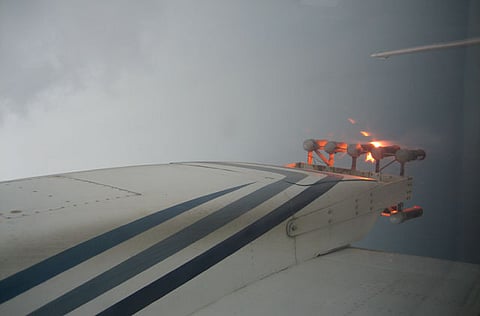124 cloud seeding operations since start of year
Residents surprised to see rain on almost daily basis in Al Ain over the summer

Al Ain: As rain pelted the United Arab Emirates in early September, residents marvelled at the rare sight of dark skies releasing pent up rainfall during the hottest season of the year.
An almost daily occurrence in eastern and some northern areas, the rainfall was marked by a little help from man, in this case an exercise known as cloud seeding, a manmade process in which materials such as salts, silver iodide or dry ice are discharged into clouds to prompt rainfall and modify the weather, a method that appears to be working given the right conditions in the UAE.
Clouds coming from Oman were targeted for the exercise.
“We are trying to reach the best procedure to enhance the amount of rainfall to recharge underground water and increase rain collected in dams,” said Ali Al Musallam, Head of the Cloud Seeding Operations Section at the National Centre of Meteorology and Seismology (NCMS).
The operation, he said, usually depends on the availability of convective or cumuliform clouds that tend to dominate over the summer.
“I was amazed to see thunderstorms with such frequency,” said Jacob Mullins, an expatriate resident in Al Ain.
Mullins said it was to unusual see thunderclouds at this time of year in the UAE.
The NCMS’s cloud seeding is, however, not based on seasons.
“Usually it depends on the availability of convective or cumuliform clouds,” said Al Musallam.
The UAE’s environment is, however, more conducive for cloud seeding in summer.
“It is due to the availability of amenable clouds ... [that] are usually convective and heaped in shape with good updraft,” he added.
Cloud seeding is a national project that has a permanent unit at the NCMS’s meteorological department. It conducts operations anywhere in the UAE with the availability of amenable clouds, mostly along the eastern mountainous terrains. “Compared with the benefits, it is not costly at all,” said the NCMS official.
The cloud seeding team starts early in the morning.
“We start our day with analysing the weather charts, we indicate the location and time of cloud accumulating, then we watch the satellite pictures to indicate the location of the beginning of cloud development, then we target the base of the cloud by using the NCMS radar network to indicate the good updraft to start the seeding operation,” said Al Musallam.
The NCMS team includes five pilots and seven cloud seeding operators on the ground. The recent operations have been conducted in the Al Ain region and its surrounding areas, with a total of 124 operations since the beginning of this year, said the official.
Talking about the success ratio, Al Musallam said the rainfall enhancement ratio is more than 35 per cent in a clear atmosphere, while it is 15 per cent in a turbid atmosphere.
He said no harmful chemicals are used in the operation.
“We use natural salt such as potassium chloride and sodium chloride,” he said. These salts are nothing in ratio when compared to their availability in the surroundings.
“Even the other approach of cloud seeding using silver iodide has a small ratio compared to the national standards, which is 0.01 microgram per litre to 5 microgram per litre, respectively,” said Al Musallam.
The cloud-seeding programme, he said, began at the end of 1990, but at the beginning of 2001 it was conducted through a scientific base in cooperation with well-known organisations such as the National Centre for Atmospheric Research (NCAR) in Colorado, USA, Witwatersrand University in South Africa, in addition to Nasa (America’s space agency.)
He said Shaikh Mansour Bin Zayed Al Nahyan, Deputy Prime Minister and Minister of Presidential Affairs, has played a vital role in the project.
“He continuously guided and advised the centre to cooperate with institutes and well-known centres that deals with cloud seeding research,” he added.
He also encouraged international scientists to dig into the different aspects of cloud seeding by announcing a cloud seeding prize in 2005.
Sign up for the Daily Briefing
Get the latest news and updates straight to your inbox



